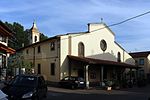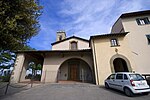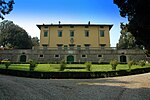Badia a Settimo
1004 establishments in Europe11th-century establishments in ItalyMonasteries in Tuscany

The Badia a Settimo or Abbazia dei Santi Salvatore e Lorenzo a Settimo is a Cluniac Benedictine abbey in the comune of Scandicci, near Florence in Tuscany, Italy. It was founded in 1004. On 18 March 1236, by order of Pope Gregory IX, the monastery passed to the Cistercians of the abbey of Galgano Guidotti. In the chapel of San Jacopo of the Badia, which dates to 1315, are frescoes, much ruined, that are the only surviving work attributed with reasonable certainty – by Ghiberti – to Buffalmacco, whose real name was Bonamico or Buonamico.
Excerpt from the Wikipedia article Badia a Settimo (License: CC BY-SA 3.0, Authors, Images).Badia a Settimo
Ciclabile Badia a Settimo,
Geographical coordinates (GPS) Address Nearby Places Show on map
Geographical coordinates (GPS)
| Latitude | Longitude |
|---|---|
| N 43.780455555556 ° | E 11.144758333333 ° |
Address
Chiesa dei Santi Salvatore e Lorenzo a Settimo
Ciclabile Badia a Settimo
50018
Tuscany, Italy
Open on Google Maps











